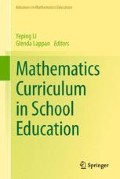Abstract
In the U.S. three curriculum strategies are being used to improve school mathematics programs and student learning outcomes: (a) the movement to common standards; (b) advances in technology-based instructional resources; and (c) the pressure of accountability measured by end-of-year assessments. Together, these strategies are creating a “perfect storm” for significant changes in mathematics curriculum. Elements of the reform strategy are reviewed and discussed. In addition, an argument is made for systematic monitoring of the initiative in order to learn about its impact and inform future policy decisions.
Access this chapter
Tax calculation will be finalised at checkout
Purchases are for personal use only
References
American Association for the Advancement of Science (2000). Middle grades mathematics textbooks: a benchmarks-based evaluation. Washington: Author.
Association of American Publishers (2010). Opportunity to learn in high-stakes testing. An AAP white paper developed by Dr. Susan E. Phillips. http://www.aapschool.org/pdf/Opptolearn-Phillipspaper.pdf.
Bandeira de Mello, V., Blankenship, C., & McLaughlin, D. H. (2009). Mapping state proficiency standards onto NAEP scales: 2005–2007 (NCES 2010-456). Washington: National Center for Education Statistics, Institute of Education Sciences, U.S. Department of Education.
Chávez, O. (2003). From the textbook to the enacted curriculum: textbook use in the middle school mathematics classroom. University of Missouri-Columbia, Unpublished doctoral dissertation.
Common Core State Standards Initiative (2010). Common core state standards for mathematics. Washington: National Governors Association Center for Best Practices and the Council of Chief State School Officers.
Confrey, J., & Maloney, A. (2011). Engineering [for] effectiveness in mathematics education. In Highly successful STEM schools or programs for K-12 STEM education: a workshop. Washington: National Academies Board on Science Education and Board on Testing and Assessment.
Confrey, J. (2007). Tracing the evolution of mathematics content standards in the united states: looking back and projecting forward towards national standards. Paper presented at the Conference on K-12 Mathematics Curriculum Standards.
Goertz, M. E. (2009). Standards-based reform: lessons from the past, directions for the future. In K. Wong & R. Rothman (Eds.), Clio at the table: using history to inform and improve education policy (pp. 201–219). New York: Peter Lang Publishing.
Hirsch, C. R. (2007). Curriculum materials matter. In C. R. Hirsch (Ed.), Perspectives on the design and development of school mathematics curricula (pp. 1–5). Reston: National Council of Teachers of Mathematics.
Kilpatrick, J. (2003). What works? In S. Senk & D. Thompson (Eds.), Standards-oriented school mathematics curricula: what does research say about student outcomes? (pp. 471–488). Mahwah: Lawrence Erlbaum Associates.
Kober, N., & Stark, D. (2011). States’ progress and challenges in implementing common core state standards. Washington: Center for Education Policy.
National Council of Teachers of Mathematics (1980). An agenda for action. Reston: Author.
National Council of Teachers of Mathematics (1989). Curriculum and evaluation standards for school mathematics. Reston: Author.
National Council of Teachers of Mathematics (2000). Principles and standards for school mathematics. Reston: Author.
National Council of Teachers of Mathematics (2006). Curriculum focal points for prekindergarten through grade 8 mathematics. Reston: Author.
Reys, B. J. (Ed.) (2006). The intended mathematics curriculum as represented in state-level curriculum standards: consensus or confusion? Charlotte: Information Age.
Reys, B. J., & Reys, R. E. (2006). The development and publication of elementary mathematics textbooks: let the buyer beware! Phi Delta Kappan, 87(5), 377–383.
Schmidt, W. H. (2012). Common core math standards implementation can lead to improved student achievement [PowerPoint slides]. Retrieved from http://www.achieve.org/CCSS-schmidt-research.
Schmidt, W. H., & Valverde, G. (1997). Policy lessons from TIMSS. Paper prepared for the National Governors Association.
Schoenfeld, A. H. (2002). Making mathematics work for all children: issues of standards, testing, and equity. Educational Researcher, 31(1), 13–25.
Seeley, C. L. (2003). Mathematics textbook adoption in the United States. In G. M. Stanic & J. Kilpatrick (Eds.), A history of school mathematics (pp. 957–988). Reston: National Council of Teachers of Mathematics.
Senk, S., & Thompson, D. (2003). Standards-based school mathematics curricula: what are they? What do students learn? Mahwah: Lawrence Erlbaum Associates.
Trafton, P., Reys, B. J., & Wasman, D. (2002). Standards-based mathematics instructional materials: a phrase in search of a definition. Phi Delta Kappan, 83(3), 259–264.
U. S. Department of Education (2001). The no child left behind act of 2001. Washington: Author. http://www.ed.gov/policy/elsec/leg/esea02/index.html. Accessed 21 October 2007.
Weiss, I. R., & Heck, D. (2011). CCSSM priority research agenda. Alhambra: Horizon Research, Inc.
Weiss, I. R., Banilower, E. R., McMahon, K. C., & Smith, P. S. (2001). Report of the 2000 national survey of science and mathematics education. Chapel Hill: Horizon Research, Inc. Retrieved February 28, 2003 from http://2000survey.horizon-research.com/reports/status.php.
Author information
Authors and Affiliations
Corresponding author
Editor information
Editors and Affiliations
Rights and permissions
Copyright information
© 2014 Springer Science+Business Media Dordrecht
About this chapter
Cite this chapter
Reys, B.J. (2014). Mathematics Curriculum Policies and Practices in the U.S.: The Common Core State Standards Initiative. In: Li, Y., Lappan, G. (eds) Mathematics Curriculum in School Education. Advances in Mathematics Education. Springer, Dordrecht. https://doi.org/10.1007/978-94-007-7560-2_3
Download citation
DOI: https://doi.org/10.1007/978-94-007-7560-2_3
Publisher Name: Springer, Dordrecht
Print ISBN: 978-94-007-7559-6
Online ISBN: 978-94-007-7560-2
eBook Packages: Humanities, Social Sciences and LawEducation (R0)

